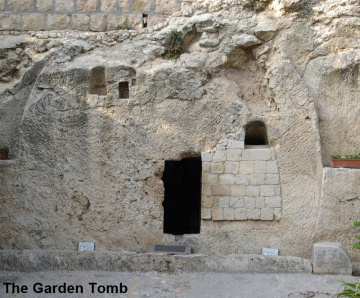The place where the body of Jesus was buried was in a garden and in a new sepulchre or tomb which never had a dead person placed in it (John 19:41). It was located outside the then current walls of the city of Jerusalem (verse 20), possibly close to the Damascus Gate.
The tomb, owned by a rich man named Joseph of Arimathea, was hewn out of a rock and had a large, round stone door that could seal the entrance (Isaiah 53:4 - 6, 10 - 11, Matthew 27:57 - 60, Luke 23:50 - 53). The interior of the tomb that contained Jesus was big enough for a person or two to sit or stand in (Mark 16:5, John 20:5 - 6, 11 - 12), although it required a person to stoop down in order to enter it.
Possible locations
There are two primary sites in Jerusalem that are identified as possible locations where Jesus was buried. They are the Church of the Holy Sepulcher and the Garden (also known as Gordon's) tomb. The church is believed to have been consecrated and built in 335 A.D., demolished in 1009, and rebuilt in 1048.

In 1842 A.D. a man by the name of Otto Thenius proposed that the place where Jesus was crucified, called Calvary (Golgotha) in Scripture, was the same as the place called the 'place of the skull.' In 1867 A.D., the discovery of a garden tomb (shown in the picture above) occurred near the place of the skull.
The connection of the garden tomb to where Christ was believed to be buried with the location of Golgotha received prominence through a British general named Charles Gordon.
In 1883, General Gordon found a rocky ridge or plateau (which today is seen from the back of a bus station) that, from several angles, looks like the face of a skull. Golgotha, the name of the place where Jesus was crucified, is an Aramaic word that means skull (Mark 15:21 - 22).
General Gordon concluded that the rocky outcrop he thought looked like a skull was high likely to have been the Biblical place known as Golgotha. This is why another name for this general location is Gordon's Tomb. Many believe (including a majority of Protestants) this location, and not the Church of the Holy Sepulcher (which is the traditional place thought to be where the burial occurred), is the place where the body of Jesus was buried.
Tomb characteristics
The Garden tomb consists of at least two chambers. To the right of the first chamber a second chamber can be seen. Benches made of stone line the walls of chamber number two, except in the places where the walls join and running along the first chamber's back wall. The benches, though heavily damaged throughout the years, can still be seen.
The groove edge outside the burial location, in the above image, is cut diagonally. As was prophesied in Isaiah (Isaiah 53:8 - 9) Jesus was buried in the tomb of a rich man even though many believed he was a criminal deserving of the death penalty (Matthew 27:57 - 60).
Who visited the burial site?
The Bible states that several people visited the garden tomb during and after Jesus was buried. They include Joseph of Arimathea, a rich member of the Sanhedrin, and Nicodemus, a Pharisee, who together placed Christ in Joseph's new burial location (Matthew 27:57 - 61, Mark 15:42 - 47, Luke 23:50 - 55, John 19:38 - 42).
Mary Magdalene and "another Mary" checked where the Lord was buried late on a Saturday afternoon just before the resurrection (Mark 16:1). Mary Magdalene and other women revisit the site early Sunday morning, with Peter and John running to the location later in the day (see Luke 24) to also check on the body of Jesus.